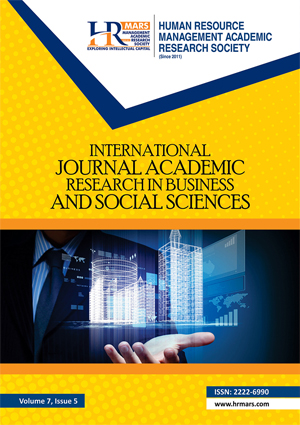
ISSN: 2222-6990
Open access
Kadazandusun language politeness from Sudawil (poetry) traditional Kadazandusun poetry, dislike of honesty (Norjietta Taisin, 2014). Comply to the rules of communication and avoid impolite speech (Fraser & Nolen, 1981). This study examines the Kadazandusun language politeness of six lecturers and nine students in lectures. Before conducting the interview, the researcher made an appointment with the participants to determine the time to observe the lecturer conducting a lecture with the IPG students. Interviews were recorded in audio and entered into Nvivo 12 plus to be interpreted to obtain themes, categories and coding. The findings of the study show that lecturers and students think that politeness in Kadazandusun language helps in the usage of politeness in Kadazandusun language in lectures with a polite attitude, voice and intonation, polite and elegant choice of words and sentences, greetings, correct calls and appropriate language style. In this study, a sub-theme that contributes to the formation of lecture themes related to aspects of Kadazandusun politeness has been formed from the knowledge and experience of lecturers and students who consequentially use Kadazandusun politeness during lectures. A discussion about the use of politeness in Kadazandusun in lectures and suggestions to increase the potential use of politeness in Kadazandusun.
Asmah. (2000). Dalam Ainal Akmar Ahmad, Maizatul Azura Yahya, Nasihah Hashim dan Noor Aida Mahmod. (2016). Kesantunan bahasa semasa komunikasidi Laman Sosial. International Conference on Goverment & Public Affair 2016 (ICOGPA2016) UUM COLGIS.
Omar, A. (2002). Setia dan Santun Bahasa. Tanjong Malim. Penerbitan Universiti Pendidikan Sultan Idris.
Gani, A. (2019). Penerapan unsur kesantunan berbahasa dalam pengajaran dan pembelajaran Bahasa Melayu di sebuah sekolah di Hulu Selangor. Universiti Pendidikan Sultan Idris. Tanjong Malim, Perak Darul Ridzuan.
Sariyan, A. (2007). Santun berbahasa. Kuala Lumpur: Dewan Bahasa dan Pustaka.
Babbie, E., and Mouton, J. (2002). The Practice of Social Research. Oxford university Press Southern Africa, Cape Town.
Brown, P., & Levinson, S. (1987). Politeness: Some universals in language usage. Cambridge: Cambridge University Press.
Creswell, J. W. (2007). Qualitative inquiry and research design: Choosing among five approaches (2nd ed). Sage Publications, Inc.
Creswell, J. W. (2012). Education research: Planning, conducting, and evaluating Quantitative and Qualitative research (4th ed). Boston, MA: Pearson.
Fraser, B., & Nolen, W. (1981). The association deference with linguistic form. Internasional Journal of The Sosiology of Language, (27), 93–109.
William, F. (1997). Anthroppological Linguistics: An Introduction. Malden: Blacwell Publishing Ltd.
Karimnia, A. (2018). Patterns of Politeness in Teacher-Student Interaction: Investigating an Academic Context Patterns. October.
Lakoff, R. (1975). Language and woman’s Place. Harper and Row.
Bagu, L., & Baga, V. (2017). Lilihis Tinungkusan Tinaru Dusun. Tuaran: Institut Pendidikan Guru Kampus Kent Tuaran.
Miles, H. B., & Huberman, A. M. (1994). Qualitative Data Analysis: An Expanded Sourcebook. Thousand Oaks, CA: Sage Publications.
Rashid, N. (2005). Nilai kesantunan dalam konteks sosiobudaya masyarakat Melayu. Jurnal Pengajian Melayu, 15, 232-253.
Taisin, N. (2014). Genre puisi lisan tradisional Kadazandusun (Sudawil): bahasa perlambangan dalam Sudawil percintaan dan kasih sayang dari dimensi alam dan budaya. Procedia- Sosial and Behavioral Sciences 134 (2014) 291-297.
Karim, N. (1981). Beberapa persoalan sosiolinguistik Melayu. Kuala Lumpur. Dewan Bahasa dan Pustaka.
Dawi, N., & Abas, A. 2020. Kesantuan berbahasa dalam kalangan pelajar Universiti Malaysia Sabah. Pusat Penataran Ilmu Bahasa, Universiti Malaysia Sabah. MANU Bil.31(2), 133-152, 2020 (Disember) E-ISSN 2590-4086. MANU Jurnal Pusat Penataran Ilmu & Bahasa (Journal of the Centre for the Promotion of Knowledge & Language Learning).
Patton, M. (1990). Qualitative evaluation and research methods (pp. 169-186. Baverly Hills, CA: Sage.
Beden, S. (2018). Kesantunan bahasa penulisan. Dewan Bahasa, September, 54-58.
Beden, S., & Zahid, I. (2016). Pemetaan struktur peristiwa bahasa: Komunikasi bebas konflik. GEMA Online, Journal of Language Studies, 16(1), 67-87.
Silverman, D. (2002). Why Interview. London, UK: SAGE Publications Skulmoski.
Silverman, W. K., & La Greca, A. M. (2002). Children experiencing disasters: Definitions, reactions, and predictors of outcomes. In A. M. La Greca, W. K. Silverman, E. M. Vernberg, & M. C. Roberts (Eds.), Helping children cope with disasters and terrorism (pp. 11–33).
Seong, T. (2003). “Kesantunan Berbahasa Kes Bahasa Melayu” dalam. Dewan Bahasa, Mac, hlm. 14-23.
Silverman, D. (2013). Doing Qualitative Research: A Practical Handbook. Sage Publications.
Effendy, T. (2011). Tenas Effendy. (2011). Kesantunan dan semangat Melayu. Pekanbaru, Indonesia: Pemerintah Kota Pekanbaru & Tenas Effendy Foundation.
George, Y. (1998). ‘The Study of Language’ (2nd ed). Cambridge: Cambridge University Press.
Dadong, V., Mosin, M. Bin, & Abdullah, M. N. A. Bin. (2025). Kadazandusun Language Politeness in IPG Student Lectures. International Journal of Academic Research in Business and Social Sciences, 15(1), 1214–1224.
Copyright: © 2025 The Author(s)
Published by HRMARS (www.hrmars.com)
This article is published under the Creative Commons Attribution (CC BY 4.0) license. Anyone may reproduce, distribute, translate and create derivative works of this article (for both commercial and non-commercial purposes), subject to full attribution to the original publication and authors. The full terms of this license may be seen at: http://creativecommons.org/licences/by/4.0/legalcode